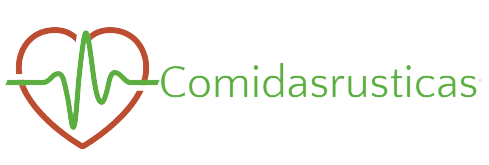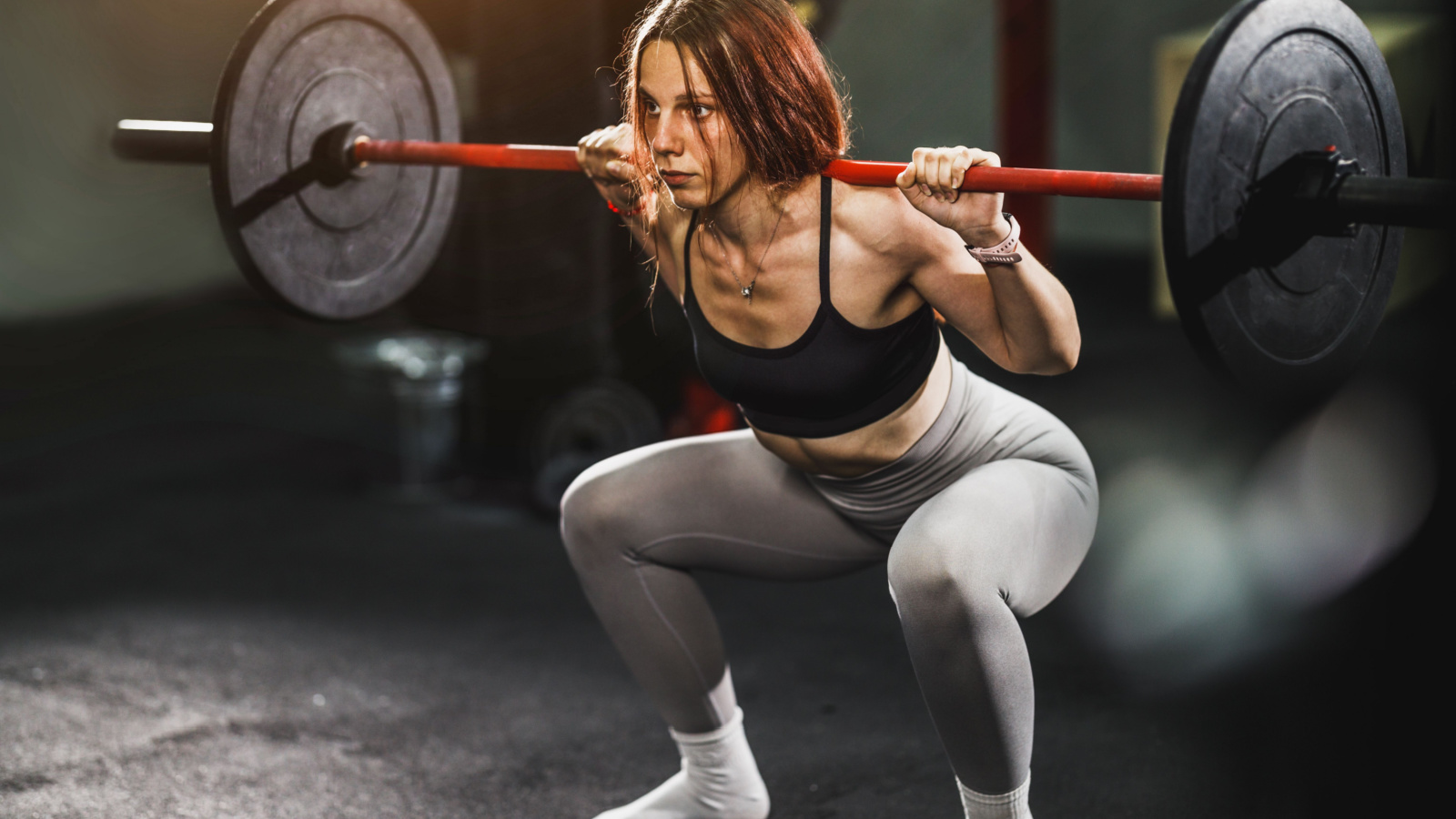The again squat, universally hailed the king of leg workouts, holds a timeless place within the realm of power coaching. It’s a fundamental barbell motion that challenges not solely your bodily power, however psychological power as properly.
The rationale it’s such a troublesome train to overcome has to do with not simply muscular energy, however muscular coordination, as properly. (1) Whenever you carry out the basic barbell squat, you’re recruiting a number of muscle teams on the identical time, from head to toe, whereas coordinating your effort amongst the bodily and technical calls for of the train.

Whereas many workouts can have their place in a leg exercise, when you’re searching for to boost the muscular density and power of your decrease physique, the again squat is the undisputed champion. It places your muscle mass to the check, because it calls for a degree of metabolic dedication that’ll set off a spike in progress hormone that performs a job in stimulating hypertrophy. (2)
Take a more in-depth look and deal with the mechanics of the squat, the muscle mass recruited, and a few easy and efficient variations that may assist you to get probably the most out of the time-tested again squat.
What Muscle groups Do Squats Work?
The way to Do the Squat— A Approach Information
The barbell again squat can seem deceptively easy at first — put the bar in your again, squat down, and arise. Nonetheless, there are various particulars to this elevate that may usually be ignored, equivalent to particular bar placement, hand and foot place, and the posture of your head and neck.
Right here’s a step-by-step information to performing the squat, together with some tricks to turn into a greater squatter. Security is essential. Make sure that to use all of those steps for each particular person repetition to not solely get stronger, however to coach smarter, too.
Step One — Set the Barbell Peak
Set the barbell at shoulder-height in a squat rack. Whenever you grip the bar, place your arms parallel to the bottom, making certain a cushty grip width that fits your shoulder mobility. Beginning with a shoulder-width grip is advisable, however modify to your particular person steadiness of mobility and stability.
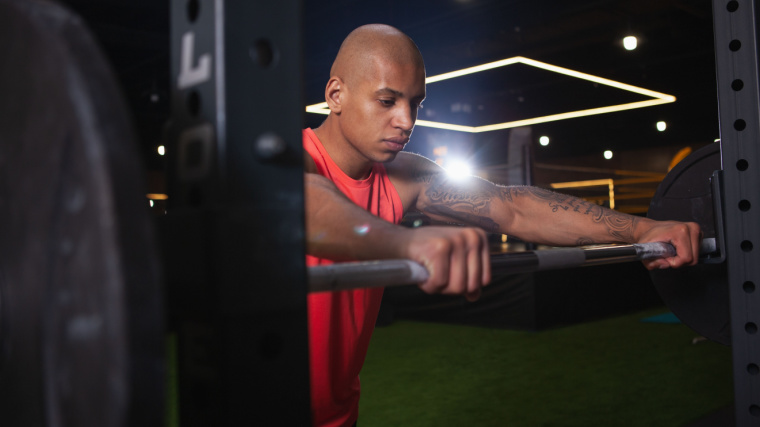
Coach’s Tip: When you encounter difficulties along with your shoulder mobility, carry out a radical upper-body warm-up earlier than beginning your leg exercise to enhance your shoulder and chest mobility.
Step Two — Place the Bar and Create a Shelf
Select between utilizing both a excessive bar or low bar placement. What deciphers between a excessive bar or low bar place is whether or not the barbell is above your rear deltoids, or on high of (or under) your rear deltoids.
A high-bar squat tends to emphasise the knee joint which might recruit extra quadricep dominance than a low-bar squat, which might place the burden nearer to the hip joint to recruit the glute muscle mass. Choose the bar placement that aligns along with your coaching targets.
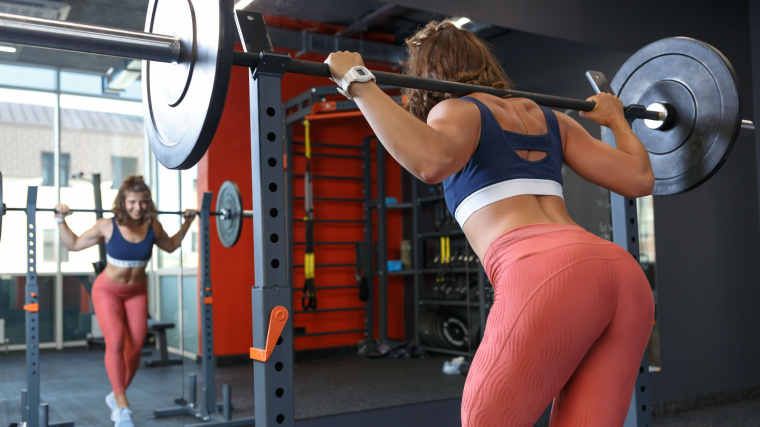
“Constructing a shelf” helps to create an area for the barbell to sit down comfortably on the higher again to squat. To construct a shelf, retract your scapulae (shoulder blades) and tighten your higher again to create a secure shelf for the bar to relaxation on.
Guarantee your elbows are positioned beneath the bar, additional securing it and selling higher posture. In case your elbows aren’t underneath the bar or close to perpendicular to the ground, your higher again may lose tightness and trigger your backbone to bend ahead.
Coach’s Tip: To assist hold your elbows beneath the bar, discover your grip width on the bar. The broader the grip, the extra mobility your shoulder should help this facet of your squatting efficiency.
Step Three — Unrack the Weight and Set Your Stance
Elevate the barbell off the J-hooks and take two steps again. When you’ve set your barbell peak accurately, it ought to be comparatively simple to unrack the burden. When stepping again, hold the preliminary step small, because the second step is primarily used to regulate your stance. Keep away from stepping too far again, as it will make it more difficult to re-rack the burden later.
Your stance considerably influences muscle engagement. For a extra quadriceps-focused squat, go for a more in-depth stance along with your toes ahead or barely outward. Athletes ought to hold their ft ahead to imitate the stance of their particular sport. (3)
If you’re searching for most squat power, angle your toes barely outward to ensure your knees keep outward in a extra advantageous place. If you wish to interact your hips extra, stand wider and switch your toes outward — a way usually utilized by powerlifters and strongman rivals.
Coach’s Tip: The strongest and comparatively greatest muscle mass of the physique are your glutes. If you wish to maximize power, you need to use a extra “glute-dominant” variation of the squat. Make sure that your ft are just a little wider than a traditional stance, along with your toes outward. Think about using a low-bar place, as properly.
Step 4 — Head Place
To take care of a flat and inflexible backbone all through the squat, be sure to place your head barely down at roughly a 45-degree angle. This head placement helps flatten the cervical backbone — the vertebrae of your neck — which helps affect the remainder of your backbone to stay secure throughout the elevate.
Coach’s Tip: When you wrestle to have good posture, begin off along with your head barely dealing with down, however, as you carry out the squat, hold your head barely ahead till you hit your sticking level shifting upward. When you hit that sticking level, tilt your head up and ahead to assist affect your backbone to “get taller.” This could put you in a greater place and enhance your squat.
Step 5 — Time to Squat
After the detailed technique of establishing in a superb place, it’s time to carry out the squat itself.
- Preliminary Section: Earlier than starting the descent, brace your core by taking a deep breath by way of your stomach, rising strain inside your belly cavity. This method enhances decrease again rigidity and general posture. Think about using a lifting belt for added help. To maintain the brace in your core, breathe by way of your nostril, and don’t permit your shoulders to rise throughout your preliminary breath.
- Descending Section: As you decrease into the squat, guarantee your hips transfer downward and barely again to distribute the burden evenly throughout your mid-foot. The purpose is to keep up correct alignment between your knee and hip joints. Purpose to achieve a cushty depth, along with your thighs close to parallel to the bottom or barely decrease.
- Ascending Section: Throughout the ascent, take note of potential “sticking factors” because the load will get heavier. When your power will get challenged, method turns into essential. The higher your method is from begin to end, the extra probably you’ll be able to battle by way of that sticking level to finish the elevate. Return upright to a full lockout.
By following every of those steps and sustaining correct kind all through the motion, you’ll maximize head-to-toe muscle engagement and scale back the probabilities of frequent errors, making certain a profitable and efficient squat.
Muscle Recruitment Throughout Squats
Time to dig deep into the anatomy of the barbell again squat, exploring the first muscle mass and secondary muscle mass required to carry out the motion.
The barbell again squat recruits a mix of main and secondary muscle mass, with the quadriceps and glutes taking the lead in knee and hip extension, respectively. Correct engagement of those muscle teams, and the help of secondary muscle mass, is essential for executing a secure and efficient squat.
Main Muscle groups
A main muscle is the primary focused muscle used throughout an supposed motion. The muscle mass are typically the bigger muscle mass of the anatomy, particularly throughout a compound motion which includes shifting at a number of joints — within the squat, you’re shifting on the hips, knees, and ankles. The first muscle mass of the squat are the quadriceps and the glute maximus.
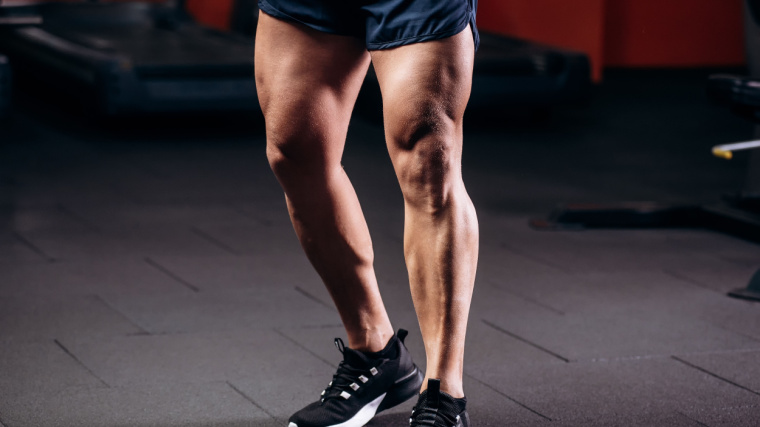
Quadriceps
- The quadriceps are a bunch of 4 muscle mass situated on the entrance of the higher leg.
- The first perform of the quadriceps is knee extension, which is essential throughout the ascending section of the squat. They play a pivotal position in straightening the knee joint as you elevate the burden.
- The quadriceps are closely engaged when an athlete depends on their knee joint to maneuver the burden. The knee joint may be prioritized throughout a high-bar squat, a squat to full (under parallel) depth, or when the athlete’s knees start to interrupt far in entrance of their toes.
Glutes
- The gluteus maximus, the biggest of the gluteal muscle mass, varieties the majority of the hip joint.
- The glutes are liable for hip extension, which is essential for rising from a squat place. They supply the ability wanted to straighten the hips.
- The gluteus maximus is closely engaged when an athlete begins to rely extra on their hip joint to drive the burden up. The hip joint may be prioritized when an athlete performs a low-bar squat, field squat, or when the athlete has “vertical shins,” which suggests they’re placing extra weight on their heels than their toes.
Secondary Muscle groups
A secondary muscle tends to be a comparatively smaller muscle group that aids the first muscle(s) with executing an train. The secondary muscle mass that present help and stabilization throughout the squat are the hamstrings, calves, decrease again, and core muscle mass.

Hamstrings
- The hamstrings are situated behind your higher leg, operating out of your hips to you knees.
- Whereas primarily liable for knee flexion (like leg curls), the hamstrings help in hip extension (straightening your higher leg in keeping with your torso). Your hamstrings assist management the descending section of the squat, performing as stabilizers.
Calves
- The calves are comprised of the gastrocnemius and soleus muscle mass, and are situated behind your decrease leg.
- The first perform of the calf muscle mass is the extension of the ankle joint — “pointing” your foot down. Whereas circuitously concerned within the squat, they assist stabilize the ankle joint, particularly when pushing by way of the mid-foot. If you wish to have an excellent squat, you need to hold your ft flat throughout every rep, which means you want nice ankle mobility, which depends on versatile calf muscle mass.
Erector Spinae (Decrease Again)
- The erector spinae muscle mass run alongside your backbone’s size, supporting and stabilizing your decrease again, particularly.
- The erector spinae muscle mass are liable for spinal extension, serving to to keep up an upright torso place throughout the squat.
Core
- Your core contains muscle mass such because the rectus abdominis, obliques, and transverse abdominis.
- Core muscle mass present stability to the torso, serving to preserve correct posture and stopping extreme spinal flexion or extension. They work at the side of the erectors, as properly.
The way to Emphasize Key Muscle groups
As talked about earlier, the first muscle mass used to squat are the quadriceps and the glutes. Nonetheless, to emphasise one muscle group over the opposite will depend on adjusting your setup and motion, together with foot placement, stance, depth, and barbell placement. (4)
Maximizing Quadriceps Recruitment
For these searching for to develop and strengthen their quadriceps, begin by positioning your ft nearer collectively, both at shoulder-width or barely narrower. This narrower stance magnifies the involvement of your quadriceps throughout the squat, intensifying their engagement.
To additional emphasize quadriceps recruitment, favor a high-bar placement with the barbell in your higher again. Inserting the bar larger in your again shifts your middle of gravity ahead, making certain that your quadriceps take the brunt of the load.
This strategic bar placement is a key factor in successfully concentrating on and strengthening the quadriceps, particularly for these in a hypertrophic (muscle-building) section of coaching.
One other trick towards quad-dominance goes under a parallel depth. This elevated depth tends to trigger the shins to lean ahead, placing the ankle inside an excellent vary of movement (also called “dorsiflexion”) which is able to put extra pressure on the knee joint. This causes the quadriceps to be extra activated.
Maximizing Glute Recruitment
In case your goal facilities on maximizing glute engagement, widen your stance past a shoulder-width place and level your toes out. This will affect your shins to remain upright, redirecting the main focus to your glutes and intensifying their involvement.
You must also use a low-bar place to shift the burden distribution at your hip joints. This helps you get a greater hip hinge, which accentuates glute recruitment. Inserting the bar decrease in your again ensures that the glutes play a extra dominant position within the squat.
For many who wrestle with feeling glute recruitment, attempt together with a “pause” within the backside place, and even use a field squat variation, because the field enforces the cue to push your hips backward as a substitute of down. That’s a key level— in case your hips transfer additional again, your glutes could be extra engaged.
Squatting straight down pushes your higher thighs ahead as you descend, inflicting your knees to be extra recruited, which might trigger a extra quadriceps-dominant motion.
Squat Variations
There are a couple of different squat variations that can be utilized to additional emphasize recruitment of both your quadriceps or glutes. By making modifications to the bar place or, in some instances, avoiding the usual barbell utterly, you’ll be able to power your physique to recruit completely different muscle mass whereas performing the identical basic squatting motion.
Entrance Squat
On this variation, the barbell is positioned on the entrance of your shoulders slightly than throughout your higher again. To realize this distinctive place, you’ll be able to both cross your arms over one another to carry the barbell or use an Olympic weightlifting-style “rack” place that places your arms parallel to one another along with your arms bent and the bar close to your fingertips.
The defining function of the entrance squat is its demand for a extra upright torso posture. That is what would make the motion extra quadriceps-dominant than glute-dominant, just like a high-bar squat.
The entrance squat promotes improved posture and spinal alignment. It strengthens your higher again whereas decreasing the chance of forward-leaning tendencies usually related to the basic barbell again squat.
SSB Squat
The SSB (security squat bar) is a specialised barbell that has pads and forward-pointing handles that maintain the burden on high of your shoulders and higher again. The load distribution creates a forward-leaning higher physique angle in comparison with a normal barbell , which considerably impacts the mechanics of the squat. This makes it a extra quadriceps-dominant variation.
The SSB squat is a perfect alternative for people who might have mobility limitations in sure areas just like the shoulders. Moreover, the SSB squat locations a considerable focus, not solely on the quadriceps, but in addition the higher again and the posterior chain. It delivers an excellent problem to not simply quadriceps power, however postural power as properly.
By way of muscle engagement, the first goal throughout the SSB squat is your quadriceps. Nonetheless, the angled handles additionally deliver your higher again and posterior chain into play. This shift in muscle emphasis units it aside from the basic barbell again squat, which primarily targets the quadriceps however doesn’t interact the higher again and posterior chain to the identical extent.
Belt Squat
The belt squat is not like the entrance squat or SSB squat. As an alternative of putting a barbell in your higher physique, you put on a belt round your waist hooked up both to a specifically designed platform or to a barbell on the bottom set in a landmine unit. The belt distributes weight throughout your hips, which makes it a glute-dominant variation of the barbell squat.
The belt squat provides an efficient technique of difficult the decrease physique with out putting weight in your torso and backbone, making it notably appropriate for people coping with again points.
Moreover, the belt squat targets your legs with little to no higher physique involvement. This may be an excellent train for these with particular limitations, together with poor shoulder mobility, spinal compression points, or an incapability to carry a barbell with one or each arms.
Time to Squat
The barbell again squat is a high train that engages a number of muscle teams and delivers large advantages, from rising power and energy to constructing extra muscular legs. Total muscle recruitment throughout squats is a vital variable that may be manipulated by your stance, motion, and bar place. Irrespective of the way you do it, the squat is an iconic elevate that may enhance anybody’s success in constructing dimension, power, and athleticism.
References
- Myer, G. D., Kushner, A. M., Brent, J. L., Schoenfeld, B. J., Hugentobler, J., Lloyd, R. S., Vermeil, A., Chu, D. A., Harbin, J., & McGill, S. M. (2014). The again squat: A proposed evaluation of useful deficits and technical elements that restrict efficiency. Energy and conditioning journal, 36(6), 4–27. https://doi.org/10.1519/SSC.0000000000000103
- Wilk, M., Petr, M., Krzysztofik, M., Zajac, A., & Stastny, P. (2018). Endocrine response to excessive depth barbell squats carried out with fixed motion tempo and variable coaching quantity. Neuro endocrinology letters, 39(4), 342–348.
- Ribeiro, Alex & Santos, Erick & Nunes, João Pedro & Amarante do Nascimento, Matheus & Graça, Ágatha & Bezerra, Ewertton & Mayhew, Jerry. (2022). A Temporary Assessment on the Results of the Squat Train on Decrease-Limb Muscle Hypertrophy. Energy and Conditioning Journal. Publish Forward of Print. 10.1519/SSC.0000000000000709.
- Larsen, S., Kristiansen, E., Helms, E., & van den Tillaar, R. (2021). Results of Stance Width and Barbell Placement on Kinematics, Kinetics, and Myoelectric Exercise in Again Squats. Frontiers in sports activities and lively residing, 3, 719013. https://doi.org/10.3389/fspor.2021.719013
Featured Picture: MilanMarkovic78 / Shutterstock
